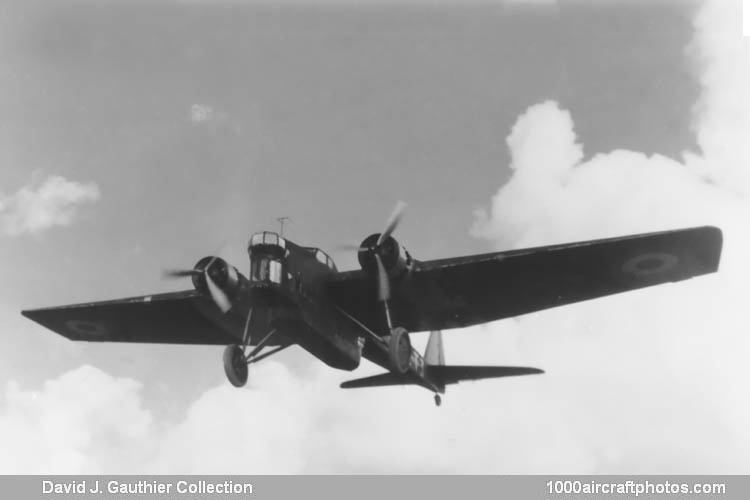12/31/2009. Remarks by Johan Visschedijk: "The forerunner of the Amiot 143 M, the Amiot 140, owed its existence to an M4 specification issued in 1928, a four-seat Multi-place de Combat suitable for day and night bombing and reconnaissance and long-range escort tasks. The Amiot 140, built by the SECM-Amiot plant at Colombes and assembled at Villacoublay, and flown for the first time in April 1931, competed for production orders against the Blériot 137, the Breguet 410 and the SPCA 30. Selected as the winning contender, the Amiot 140 was ordered into production in November 1933, an initial order being placed in that month for 40 aircraft.
In the meantime, the SECM-Amiot had been developing the basic design and was offering the Amiot 142 M4 with 860 hp Hispano-Suiza 12Ybrs supercharged liquid-cooled engines and the Amiot 143 M4 with supercharged Gnome & Rhône 14K Mistral-Major air-cooled radials, and early in 1934 the initial production order for the Amiot 140 was amended to apply to the more powerful Amiot 143, a further prototype, the Amiot 143.01 flying in August 1934.
The Amiot 143.01 had a Gnome & Rhône 14Kdrs engine in the starboard nacelle and a 14Kgrs engine in the port nacelle, these being rated at 800 hp for take off, and such was the thickness of the wing that access to the power p1ants was possib1e in flight. After the first flight of the prototype the vertical tail surfaces were enlarged, and during September 1934 some reinforcing of the fuselage was carried out.
In the following December the engine bearers were lengthened by 9.84 in (25 cm), and in January 1935 new gun turrets were installed. In February 1935, the Amiot 143.01 was joined by the Hispano-Suiza 12Y-powered Amiot 142.01, although, in the event, this aircraft was to be re-engined with Hispano-Suiza 14HA air-cooled radials and, ultimately, with Gnome & Rhône 14K engines when it was delivered to the Armée de l'Air some two-and-a-half years later as the Amiot 143 No. 75.
Bombing and gun-firing trials with the Amiot 143.01 at Cazaux which began in mid-April 1935 coincided with the first flight tests of the production Amiot 143 No. 1 with Gnome & Rhône 14Kirs (starboard) and 14Kjrs engines offering 900 hp at 13,820 ft (4,212 m), and driving three-blade Gnome & Rhône airscrews, the pitch of which could be adjusted on the ground.
The Amiot 143 Ms built against the initial contract (Nos. 1 to 40) had 106 gal (400 l) tanks between the fuselage and engine nacelles on each side, an 148 gal (560 l) tank in each inboard wing leading edge, and two 106 gal (400 l) tanks outboard of the engine nacelles, providing a total fuel capacity of 720 gal (2,720 l), all tanks being jettisonable. With the forty-first and subsequent aircraft all fuels tanks were transferred to the outer wing sections and the tanks could no longer be jettisoned.
Defensive armament comprised a single 0.303 in (7.7 mm) Lewis gun in a manually-operated nose turret, two Lewis guns in a dorsal turret, and a pair of Lewis guns on a semi-circular rail in the aft ventral step. With the 41st aircraft the Lewis guns were supplanted by a single 7.5 mm. MAC 1934 machine gun in each position, a supplementary 0.3 in (7.5 mm) gun was mounted on a flexible mounting to fire through a hatch in the floor of the forward fuselage. The bomb bay could accommodate four 220 lb (100 kg) of 441 lb (200 kg) in a single rack, 16 vertically-mounted 110 lb (50 kg) bombs or 64 22 lb ( 10 kg) bombs in two racks.
Of all-metal construction, the Amiot 143 had an immensely thick wing comprising five sections built up on three duralumin tube girder spars with widely-spaced tube-girder ribs to which an outer skinning of duralumin sheet was riveted, the stub center section being built integral with the fuselage. The two inner wing sections carried the engines, and the outer sections (from the 41st aircraft) housed tanks, both engines and tanks being accessible in flight for minor adjustments by means of a tunnel between the spars."
